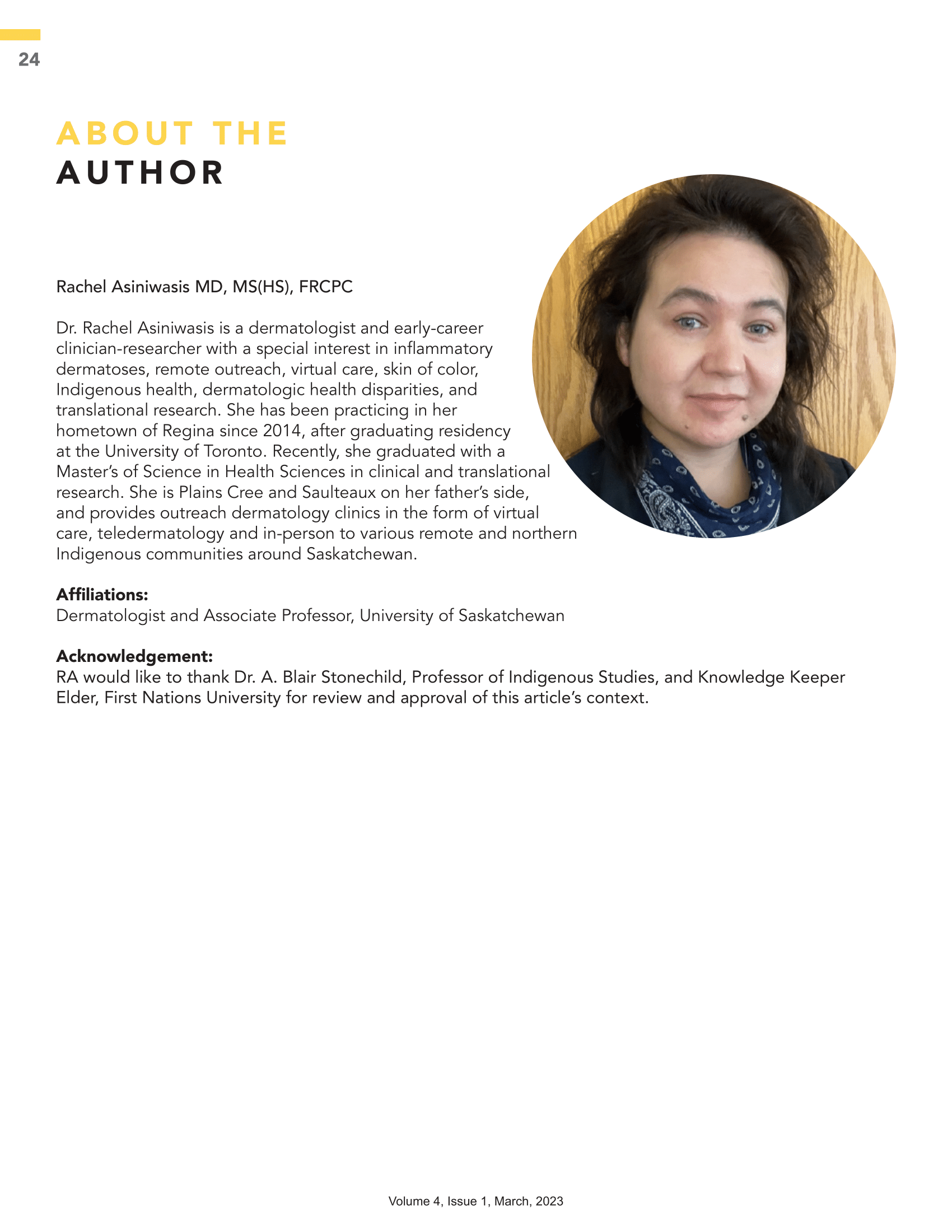Bacterial Skin Infection Burdens in Northern and Rural Canadian Indigenous Communities: A Review of National and Regional Data, and Evidence-Based Solutions
Abstract
As a visible organ, the skin reveals powerful information about both internal and external health. Canada is the world’s second largest country landmass, and approximately 60% of Canadian Indigenous peoples reside in Northern and/or Rural Communities (NRCIC), which are generally underserviced. Barriers such as lack of health care access lead to skin health disparities, which are evident in the literature documenting high burdens of bacterial skin and soft tissue infections (SSTIs) in NRCIC across Canada, mainly caused by Staphylococcus aureus (including methicillin-resistant Staphylococcus aureus [MRSA]) and Streptococcus. A review of national and regional data published over the last 15 years is included, followed by narrative synthesis of evidence-based solutions.
References
OECD (2022). Profile of Indigenous Canada: Trends and Data Needs. Organisation for Economic Cooperation and Development. Retrieved from https://www.oecd-ilibrary.org/sites/e6cc8722-en/index.html?itemId=/content/component/e6cc8722-en.
Jeong D, Nguyen HNT, Tyndall M, Schreiber YS. Antibiotic use among twelve Canadian First Nations communities: a retrospective chart review of skin and soft tissue infections. BMC Infect Dis. 2020;20(1):118.
Public Health Agency of Canada. Canadian Antimicrobial Resistance Surveillance System 2017 Report. Ottawa; 2018. Retrieved from: https://www.canada.ca/content/dam/phac-aspc/documents/services/publications/drugs-health-products/canadian-antimicrobial-resistancesurveillance-system-2017-report-executive-summary/CARSS-Report-2017-En.pdf
Matlow A, Forgie S, Pelude L, et al. National surveillance of methicillin-resistant Staphylococcus aureus among hospitalized pediatric patients in Canadian acute care facilities, 1995-2007. Pediatr Infect Dis J. 2012;31(8):814-820.
Muileboom J, Hamilton M, Parent K, et al. Community-associated methicillin-resistant Staphylococcus aureus in northwest Ontario: A five-year report of incidence and antibiotic resistance. Can J Infect Dis Med Microbiol. 2013;24(2):e42-e44.
Loewen K, Bocking N, Matsumoto CL, Kirlew M, Kelly L. Epidemiologic features of invasive group A Streptococcus infection in a rural hospital: 6-year retrospective report and literature review. Can J Rural Med. 2017;22(4):131-138.
Bocking N, Matsumoto CL, Loewen K, et al. High incidence of invasive group A streptococcal infections in remote indigenous communities in northwestern Ontario, Canada. Open Forum Infect Dis. 2016;4(1):ofw243. Published 2016 Dec 7. doi:10.1093/ofid/ofw243.
Athey TB, Teatero S, Sieswerda LE, et al. High incidence of invasive group A streptococcus disease caused by strains of uncommon emm Types in Thunder Bay, Ontario, Canada. J Clin Microbiol. 2016;54(1):83-92. doi:10.1128/JCM.02201-15.
Gordon J, Kirlew M, Schreiber Y, et al. Acute rheumatic fever in First Nations communities in northwestern Ontario: social determinants of health “bite the heart”. Can Fam Physician. 2015;61(10):881-886.
Jacob J, Bocking N, Hummelen R, et al. The development of a community-based public health response to an outbreak of post-streptococcal glomerulonephritis in a First Nations community. Can Commun Dis Rep. 2021;47(7-8):339-346. Published 2021 Jul 8. doi:10.14745/ccdr.v47i78a07.
Mashru J, Kirlew M, Saginur R, Schreiber YS. Management of infectious diseases in remote northwestern Ontario with telemedicine videoconference consultations. J Telemed Telecare. 2017;23(1):83-87. doi:10.1177/1357633X15625136.
Ya Li, Martin I, Tsang R, Squires SG, Demczuk W, Desai S. Invasive bacterial diseases in northern Canada, 2006-2013. Can Commun Dis Rep. 2016;42(4):74-82. Published 2016 Apr 7. doi:10.14745/ccdr.v42i04a01.
Dalloo A, Sobol I, Palacios C, Mulvey M, Gravel D, Panaro L. Investigation of community-associated methicillin-resistant Staphylococcus aureus in a remote northern community, Nunavut, Canada. Can Commun Dis Rep. 2008;34(5):1-7.
Golding GR, Levett PN, McDonald RR, et al. High rates of Staphylococcus aureus USA400 infection, Northern Canada. Emerg Infect Dis. 2011;17(4):722-725.
Larcombe L, Waruk J, Schellenberg J, Ormond M. Rapid emergence of methicillin-resistant Staphylococcus aureus (MRSA) among children and adolescents in northern Manitoba, 2003-2006. Can Commun Dis Rep. 2007;33(2):9-14.
Bollinger M, Hamilton M, Schroeder K, et al. Vancomycin use in a rural hospital: a 3-year retrospective study. Can J Rural Med. 2015;20(2):56-62.
Daley P, Bajgai J, Penney C, et al. A cross sectional study of animal and human colonization with methicillin-resistant Staphylococcus aureus (MRSA) in an Aboriginal community. BMC Public Health. 2016;16:595. Published 2016 Jul 19. doi:10.1186/s12889-016-3220-9
Golding GR, Quinn B, Bergstrom K, et al. Community-based educational intervention to limit the dissemination of community-associated methicillin-resistant Staphylococcus aureus in Northern Saskatchewan, Canada. BMC Public Health. 2012;12:15. Published 2012 Jan 6. doi:10.1186/1471-2458-12-15.
Plumb et al. Acceptability of household practices to prevent boils in rural Alaska. Journal of Environmental Health. 2021;84(1):26-34.
Raczniak GA, Gaines J, Bulkow LR, et al. A survey of knowledge, attitudes, and practices towards skin and soft tissue infections in rural Alaska. Int J Circumpolar Health. 2016;75:30603. Published 2016 Feb 23. doi:10.3402/ijch.v75.30603
Australian Healthy Skin Consortium (2018). National Healthy Skin Guideline: for the Prevention, Treatment and Public Health Control of Impetigo, Scabies, Crusted Scabies, and Tinea for Indigenous Populations and Communities in Australia – 1st edition.


